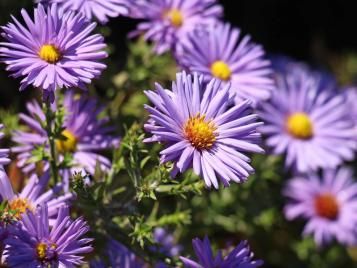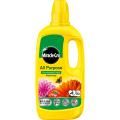

How to grow Asters
Asters are easy to grow plants that flower in late summer and autumn. Also known as the Michaelmas daisy, Asters are perennials which produce lots of colourful daisy-like flowers year after year. They are well suited to a mixed border amongst other plants, where their bountiful pollen and nectar will bring in lots of beneficial wildlife.
Types of Asters to grow
The Aster amellus is one species of Aster flower in a family of thousands. It is widely known as the European, or Eurasian, type of Aster. There are also North American types of Aster which are known as Symphyotrichum spp. and Eurybia. The European species is most commonly found in the UK, and is well suited to our climate.
There are lots of varieties and cultivars of Aster amellus. They all typically reach about 50cm (20”) in height, and have attractive dark green foliage borne on erect, slim stems. The composite flowers are usually lilac, but can be pink too.
- Aster amellus ‘King George’. A long flowering period and large flowers make this a choice cultivar.
- Aster amellus 'Rosa Erfulling’. Soft pink flowers and a clumping habit make this an eye-catching feature-plant for a small border.
- Aster amellus ‘Sonia’. A pink flowered cultivar that can reach up to 60cm (24") tall.
- Aster amellus ‘Veilchenkönigin’. Purple flowers of up to 5cm (2") across and mildew-resistance make this a great cultivar for a humid atmosphere.

What you’ll need to grow Asters
To plant an Aster you will need:
- Gloves.
- Garden spade.
- Horticultural grit.
- Aster plant.
- Miracle-Gro® Peat Free Premium Border Booster Soil Improver.
- Watering can.
- SlugClear™ Slug & Snail Barrier.
- Levington® Composted Bark.
- BugClear™ Ultra 2.
Where to plant and place your Asters
Aster amellus are really well suited to a garden border where they can receive plenty of sun. Make sure that the location has well-drained soil and consistent moisture. Avoid planting them in heavy clay soils.
Position alongside Rudbecki, Chrysathemum and Phlox for a traditional cottage-like feel. If space allows, plant several Aster amellus in clumps or spread at even intervals, for a bold and colourful display later in the year. Alternatively, Aster amellus can be grown in a container, but will need careful monitoring to make sure they don’t dry out.
Plants will spread up to 50cm (24") across, so allow plenty of space between them. Aster amellus are prone to powdery mildew so be sure to allow good airflow around them.
When to plant Asters
Plant Aster amellus outdoors in the spring (March - May).
How to plant Asters
- Always wear gloves when handling compost and plants.
- Use a garden spade or trowel to dig a hole slightly deeper and wider than the rootball of the Aster amellus.
- Add a spade full of horticultural grit to the bottom of the hole.
- Place the Aster amellus in the hole so that the top of the rootball is just beneath the surface of the soil. Backfill the soil and gently firm it in to ensure good contact with the roots.
- Add some Miracle-Gro All Purpose Continous Release pellets avoiding any stems and gently fork in.
- Fill the watering can and give the newly plant Aster a good soaking.
- Apply SlugClear™ Slug & Snail Barrier to protect young plants from unwanted pests.
- Water well until established.
Caring and nurturing your Asters
Watering: Water regularly, especially when the soil is dry. This is especially important for pot grown Asters, which can easily dry out.
Fertilising: Feed at planting time in the spring with a continuous release feed.
Deadheading: Remove dead flowerheads during September and October. This will help the Aster amellus to produce more flowers, up until the first frosts, when the plant will naturally stop flowering.
Dividing: Divide every 3-4 years to maintain good air circulation around the plant - and to create more plants for repotting!
Overwintering: Aster amellus are hardy even in heavy frosts. Either cut stems to ground level after flowering in late autumn or in mid spring and then add a layer of mulch as long as the soil is moist.
Light conditions: Provide plenty of sunlight. Aster amellus will grow in partial sun, but will not thrive in heavily shaded conditions.
Temperature and humidity: Aster amellus enjoy summer heat, but not humidity, which can lead to mildew issues.
When do Asters flower?
Aster amellus flowers from July through to October. Stake stems with canes in the spring to ensure that they are not damaged by windy weather. Pinch out the tips of new shoots in late spring to encourage the development of more flowers later in the year. Once flowering begins, cut stems for bringing into the home as cut flowers. Leave some in the garden for all of those helpful pollinators to forage from.
Frequently asked questions about Asters
What does ‘Aster’ mean?
‘Aster’ comes from the Greek word for star, in reference to the shape of the flower.
Which month of the year is the Aster the birth flower for?
Asters are associated with birthdays in September.
When should I divide my Aster amellus?
Divide plants in the spring, as they are just coming out of their dormant period.
Common pests and diseases with Asters
Aster amellus are susceptible to some well known pests and diseases, but all are easily managed. Look out for:
Powdery mildew
Monitor for a powdery coating on leaves. See our handy guide for treating this disease.
Rust
Watch out for rusty brown spots on foliage, and treat following our guidance.
Slugs and snails
Especially a problem for young plants, look out for nibbled foliage and shiny trails. Use SlugClear™ Slug & Snail Barrier and check out our tips for dealing with this pest.
Aphids
Clusters of small green or grey bugs, which can deposit a sticky substance on the tops of leaves. Apply BugClear™ Ultra 2 and read our advice for dealing with aphid infestations.
Key features of Asters
| Botanical Name | Aster amellus |
|---|---|
| Plant Type | Herbaceous perennial |
| Family | Asteraceae |
| Light Exposure | Full sun to partial shade |
| Soil pH | Neutral or slightly alkaline |
| Flowering Time | July to October |
| Flower Colour | Purple or pink |




